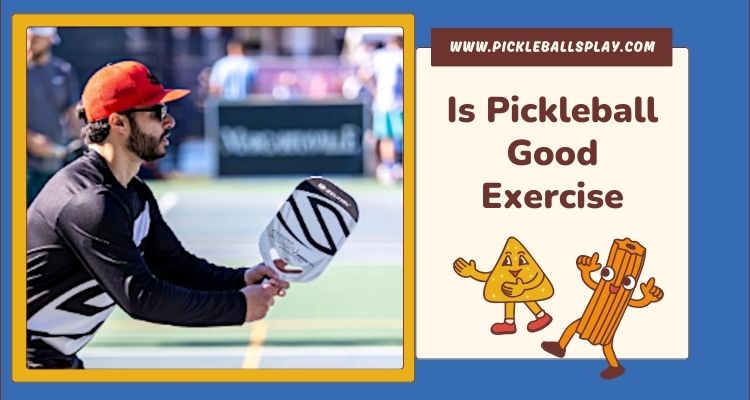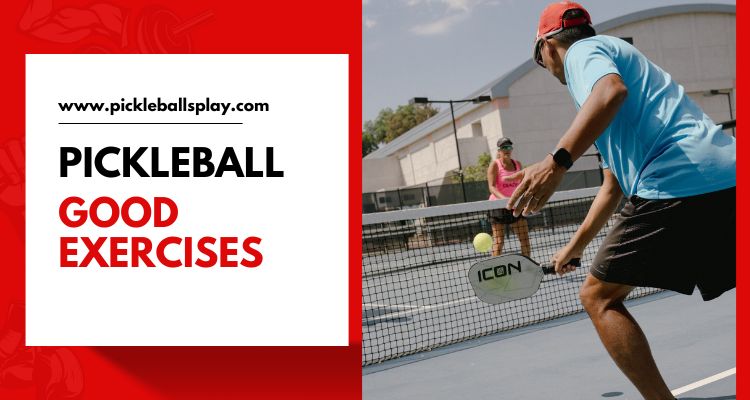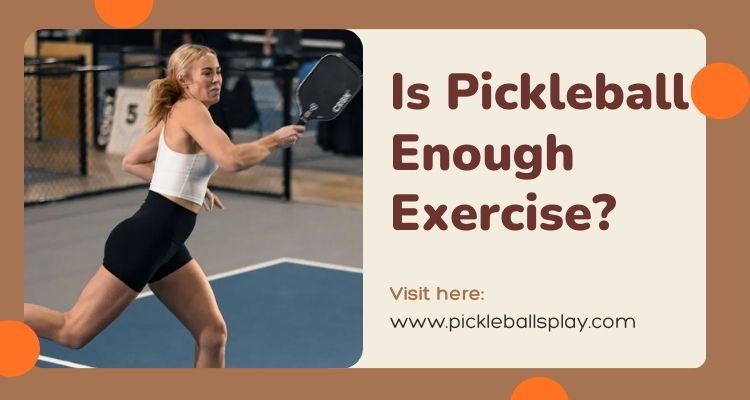Pickleball has surged in popularity, with over 19.8 million players in the U.S. alone in 2024, growing by 45.8% from the previous year. But is pickleball good exercise? This question is on the minds of fitness enthusiasts, older adults, and younger players alike. The answer lies in its unique blend of physical, mental, and social benefits, making it a compelling workout option for diverse groups. Backed by recent studies and expert insights, this article explores why pickleball is a stellar choice for staying active in 2025.

Physical Fitness Benefits of Pickleball
Pickleball combines cardiovascular activity, strength, and agility, offering a full-body workout. Its smaller court size (20×44 feet) and low-impact nature make it accessible, yet it delivers measurable fitness gains.
Cardiovascular Health
Pickleball elevates heart rate, promoting heart health and endurance. A 2023 Apple Heart and Movement Study analyzed 26,683 pickleball workouts, finding participants averaged a peak heart rate of 143 beats per minute, reaching 70% of their estimated maximum heart rate. This aligns with moderate-intensity exercise, as defined by federal guidelines recommending 150 minutes weekly for adults.
- Moderate Intensity: Players can talk but not sing, hitting 60-80% of heart rate reserve (HRR).
- Calorie Burn: An hour of pickleball burns 300-500 calories, depending on intensity and player weight.
- Endurance: Prolonged play, with games lasting 15-25 minutes, builds stamina.
Strength and Muscle Toning
The sport engages multiple muscle groups through paddling, lateral movements, and quick pivots. While not a replacement for weight training, it supports functional strength.
- Upper Body: Serving and volleying work the shoulders, arms, and core.
- Lower Body: Lunges and side-to-side movements strengthen legs and glutes.
- Core Stability: Maintaining balance during rallies enhances core muscles.
Balance, Coordination, and Flexibility
Pickleball’s fast-paced nature hones balance and hand-eye coordination, critical for injury prevention, especially in older adults. A 2024 scoping review in the Journal of Physical Activity and Health noted improvements in flexibility, balance, and lower extremity strength among older players.
- Agility: Quick directional changes improve reflexes.
- Coordination: Tracking the perforated ball sharpens hand-eye skills.
- Flexibility: Stretching for shots enhances joint mobility.
| Physical Benefit | Impact |
|---|---|
| Cardiovascular Health | Elevates heart rate to 60-80% HRR, burns 300-500 calories/hour |
| Strength | Engages upper body, lower body, and core for functional muscle toning |
| Balance & Coordination | Improves reflexes, hand-eye coordination, and reduces fall risk |
| Flexibility | Enhances joint mobility through dynamic movements |

Mental and Cognitive Benefits
Beyond physical gains, pickleball boosts mental health and cognitive function, making it a holistic exercise choice.
Cognitive Enhancement
The sport demands strategic thinking, quick decision-making, and multitasking. Players must track the ball, anticipate opponents’ moves, and manage complex scoring, which sharpens cognitive flexibility. A 2024 study highlighted pickleball’s role in improving reaction times and complex thinking, particularly in older adults.
- Reaction Time: Rapid responses to volleys enhance neural processing.
- Memory: Tracking scores and court positioning supports memory function.
- Problem-Solving: Strategizing shots fosters cognitive agility.
Stress and Mood Improvement
Exercise releases endorphins, and pickleball’s fun, social nature amplifies this effect. The Apple Heart and Movement Study’s 2022 mental health survey found frequent pickleball players (10+ sessions) reported lower depression scores on the PHQ-2 scale compared to the general population.
- Stress Relief: Social play distracts from daily stressors.
- Mood Boost: Competitive yet friendly games increase life satisfaction.
- Emotional Regulation: The sport’s engaging pace helps manage anxiety.
Social and Psychological Advantages
Pickleball’s social aspect sets it apart from many workouts. Its accessibility across ages fosters unique community dynamics, enhancing mental well-being.
Social Connection
The sport’s doubles format and court proximity encourage interaction. A 2024 study found players who participated multiple times monthly for a year reported the highest levels of social connection, reducing loneliness, especially among seniors.
- Community Building: Clubs and tournaments foster friendships.
- Inclusivity: Men, women, and kids often play together, unlike other sports.
- Bonding: Casual play allows conversations, strengthening relationships.
Psychological Well-Being
Regular play correlates with increased life satisfaction and reduced depressive symptoms. The social and competitive elements create a sense of purpose, particularly for older adults facing isolation.
- Sense of Achievement: Winning rallies or improving skills boosts confidence.
- Motivation: The sport’s addictive nature encourages consistent exercise.
- Fun Factor: Its playful vibe makes workouts enjoyable, sustaining engagement.

Is Pickleball Enough Exercise?
While pickleball offers robust benefits, its intensity varies. A 2022 Washington Post study noted players need 4.5 hours weekly to meet moderate exercise guidelines, as it yields fewer steps (about half of a brisk walk) and reaches vigorous intensity only 30% of the time. For younger or fitter individuals, it may not match the challenge of jogging or singles tennis. However, its low-impact nature makes it sustainable for long-term fitness.
- Older Adults: Ideal for maintaining health without joint stress.
- Beginners: A great entry point to regular exercise.
- Athletes: Best paired with strength training or higher-intensity cardio.
Read More: Pickleball Scoring Rules for Singles And Doubles
Potential Risks and Considerations
Pickleball isn’t without risks. Injuries, particularly among older players, are rising due to its popularity. Common issues include sprains, strains, and falls, with a 2024 review noting the need for more injury research.
- Injury Prevention: Warm-ups, proper shoes, and technique coaching reduce risks.
- Overuse: Vary activities to avoid repetitive strain.
- Consult Professionals: Check with a doctor if you have joint or heart concerns.
Pickleball in 2025: Why It’s a Fitness Trend
With 70,641 courts and 16,210 play locations in the U.S. as of 2025, pickleball’s accessibility fuels its fitness appeal. Its growth (311% over three years) reflects its effectiveness as exercise that’s fun and inclusive. Innovations like smartwatch tracking and new paddle technologies (e.g., Six Zero DBD) enhance the experience, while tournaments and collegiate leagues attract younger players, broadening its fitness reach.
FAQs About Pickleball as Exercise
Is pickleball considered a good workout for weight loss?
Yes, pickleball burns 300-500 calories per hour, supporting weight loss when paired with a balanced diet. Its engaging nature encourages regular play, aiding consistency.
Can pickleball improve mental health?
Absolutely. Studies show it reduces depression and anxiety, boosts mood, and fosters social connections, especially for older adults.
Is pickleball suitable for seniors?
Yes, its low-impact nature makes it ideal for seniors, improving balance, coordination, and heart health while minimizing joint stress.
How does pickleball compare to tennis for exercise?
Pickleball is less intense, with a peak heart rate of 143 bpm versus tennis’s 152 bpm. Tennis has 9% more time in vigorous zones, but pickleball is gentler on joints.
How much pickleball should I play for fitness benefits?
Aim for 4.5 hours weekly to meet moderate exercise guidelines, or 150 minutes of moderate-intensity play, per federal recommendations.
Conclusion
Is pickleball good exercise? Unequivocally, yes. Its cardiovascular, strength, and cognitive benefits, combined with social and psychological perks, make it a standout fitness activity in 2025. Whether you’re a senior seeking low-impact movement, a beginner building habits, or an athlete diversifying workouts, pickleball delivers. With its explosive growth and accessibility, it’s no wonder millions are picking up paddles to stay fit. Grab yours, hit the court, and experience the exercise revolution firsthand.




